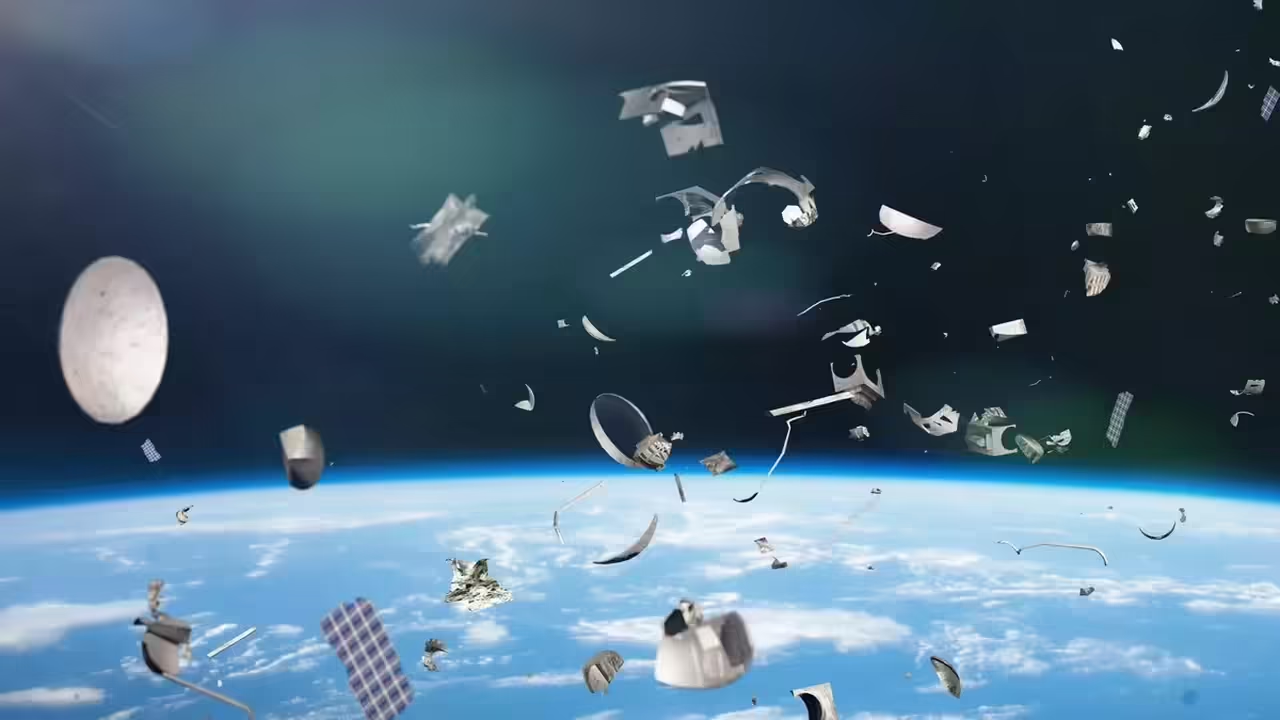
Space debris is an environmental problem that is of increasing concern to scientists. It refers to all man-made objects orbiting the Earth that no longer have any useful function. These objects can range from decommissioned satellites to fragments of rockets or collisions between space objects.
Space debris poses a risk to space missions, the International Space Station and operational satellites that provide essential services such as communications, navigation or Earth observation. In addition, space debris can generate light pollution that hinders astronomical observations from the Earth’s surface.
According to the European Space Agency (ESA), there are an estimated 9,000 satellites in orbit, of which about 5,000 are active. This figure is expected to increase to 60,000 satellites by the end of this decade due to the accelerated development of the space industry. There are also an estimated 100 trillion pieces of unidentified space debris that can reach very high velocities and cause serious damage.
In view of this situation, scientists are calling for the establishment of legally binding international treaties to regulate the responsible and sustainable use of space. These treaties should include measures to prevent the generation of more space debris, to remove disused objects from the most congested orbits, and to protect space as a common good of humanity.
The growing threat of space debris
Space debris is a growing problem that threatens the future of space exploration and utilization. It is any human-made object orbiting the Earth that no longer has any useful function. These objects can range from decommissioned satellites to rocket fragments to loose parts, paint or dust.
According to the European Space Agency (ESA), there are an estimated 900,000 objects larger than one centimeter with no useful function orbiting the Earth. These objects represent a collision risk for operational satellites, which are essential for many human activities, such as communications, navigation, meteorology or scientific research. In addition, collisions can generate more fragments, increasing the space debris problem.
The UN has warned that space debris endangers terrestrial communications and has urged countries to take measures to minimize it. Some of these measures include: avoiding leaving objects in orbit after their useful life, designing space equipment to be more resilient and easier to de-orbit, performing evasive maneuvers to prevent collisions, and developing technologies to remove the most dangerous objects from space.
Space debris is a challenge that requires international cooperation and commitment to space sustainability. Failure to act soon could reach a point where near-Earth space is inaccessible to future generations.
The magnitude of the problem: Alarming figures on space debris
Space junk is a term used to describe man-made objects orbiting the Earth that no longer have any useful function. These objects can range from inactive satellites to rocket fragments, lost tools or paint flakes. Space debris poses a risk to space missions, terrestrial telecommunications and the environment.
According to data provided by the European Space Agency (ESA), it is estimated that there are more than 130 million objects between 1 millimeter and 1 centimeter in size, and some 34,000 objects larger than 10 centimeters orbiting the Earth. These objects move at speeds in excess of 28,000 kilometers per hour, making them potential projectiles capable of causing serious damage or even destroying other spacecraft.
Space debris has been accumulating since the beginning of the space age in 1957, when the first artificial satellite, Sputnik, was launched. Since then, there have been more than 6,250 launches into space, putting some 13,630 satellites into orbit, of which only about 6,600 are still operational. The rest have become space junk, along with the remains of rocket stages and fragments generated by collisions, explosions or deterioration.
The UN has long warned of the serious problem posed by space debris and has adopted a set of guidelines for its mitigation. However, these guidelines are not binding and depend on the will of States and space agencies. Some proposed measures include improving the design of spacecraft to avoid the generation of fragments, reducing the time they remain in orbit after the end of their mission, avoiding collisions by tracking and controlling trajectories, and developing technologies to actively remove space debris.
How Space Debris Originates: Sources and Causes
Rocket and satellite launches: each time a rocket or satellite is launched into space, a variety of debris, such as rocket stages and satellite parts, is generated and can become space debris.
Collisions between objects: when two orbiting objects collide, they can fragment into small pieces that become new debris.
Natural wear and tear: the passage of time and the extreme conditions of space can cause objects in orbit to slowly disintegrate, generating small particles of debris.
Abandonment of objects: some objects in orbit, such as obsolete satellites or rocket stages, are simply abandoned in space instead of being safely removed.
Human error: in some cases, space debris originates from human error, such as the loss of tools or equipment during spacewalks.
The Dangers of Space Debris: Threats to Space Exploration and Life on Earth
Space debris poses a number of hazards to both space exploration and life on Earth. Here are some of the main risks associated with space debris:
Collisions: space debris moves at very high speeds and can collide with satellites, manned spacecraft and space stations, which can cause severe damage or even destruction of the affected objects.
Generation of more debris: collisions between objects can generate even more space debris, increasing the possibility of future collisions and damage to space infrastructure.
Threat to human safety: fragments of space debris can fall to Earth and pose a threat to human safety, especially if they impact populated areas.
Space pollution: space debris can also contaminate outer space with toxic or hazardous substances, which can have negative effects on the health of astronauts and space biodiversity.
Risks to the economy and communications: the destruction of satellites and other objects in orbit can have negative impacts on the global economy and communications.
Proposed solutions: How can we solve the space debris problem?
Fortunately, innovative and coordinated solutions are being proposed and explored to address this problem.
Removal of space debris: One of the most obvious ways to address the space debris problem is to remove it from orbit. Technologies such as satellites and robots are being developed to capture and remove space debris, and different methods such as nets, harpoons and gas jets have been proposed to capture and remove larger objects. Methods such as solar sail-assisted de-orbiting, which harnesses the pressure of sunlight to slow down objects and cause them to disintegrate in the Earth’s atmosphere, are also being explored.
Designing safer satellites: Another way to reduce the generation of space debris is to design safer and more sustainable satellites and rockets. This could include the use of more durable and impact-resistant materials, the elimination of unnecessary components, and the incorporation of propulsion systems that allow for safe removal from space once the satellite has completed its useful life.
International collaboration: International collaboration is crucial to address the space debris problem. International policies and agreements are needed to coordinate space debris removal efforts, prevent the generation of new debris, and hold countries and companies that generate space debris accountable. The creation of a global database of objects in orbit could also be useful to prevent collisions and coordinate the removal of specific objects.
Public education and awareness: finally, it is important to educate and raise public awareness of the space debris problem and the need to address it. This could include information and awareness campaigns about the risks associated with space debris, as well as initiatives to reduce debris and promote sustainability in space exploration.
The most hazardous debris: What objects contribute most to space debris?
While space debris includes objects of different sizes, some are more hazardous than others. Here are some of the most hazardous debris that contribute to space debris:
Satellite and rocket fragments – Satellite and rocket fragments are some of the largest and most dangerous objects in space debris. These objects can travel at speeds of up to 28,000 kilometers per hour and have the potential to cause significant damage in the event of a collision. In addition, these fragments can generate more space debris in the event of a collision.
Tools and other objects lost during space missions: During space missions, it is common for tools and other objects, such as gloves and cameras, to be lost. These objects can become space debris and, although small in size, can still cause collisions and damage to satellites and spacecraft.
Debris from explosions: Explosions from satellites and rockets in orbit can generate a large amount of debris, including fragments of objects and pieces of hardware. This debris can travel at extremely high speeds and pose a significant hazard to space infrastructure.
Abandoned satellites and spacecraft: Abandoned satellites and spacecraft are another major space debris problem. These objects can be very large and heavy, making them a potential hazard in the event of a collision. In addition, these objects may contain fuel and other hazardous chemicals that can generate pollution and damage the health of the planet.
Space debris cleanup is a significant technical and economic challenge due to the large number of objects in orbit and the extremely high velocities at which they move. Some of the processes that have been proposed to clean up space debris are described below:
Capture and disposal: this technique involves capturing space debris with a net or mechanical arm and then dragging it through the Earth’s atmosphere, where it would burn up completely. Different designs have been proposed to capture space debris, such as nets, harpoons, and mechanical arms.
Laser cleaning: this technique involves using a laser to heat the space debris, which generates a small amount of propulsion and can move the objects to a lower orbit, where they will eventually burn up in the atmosphere. This technique is suitable for small, lightweight objects, but is not effective for larger, heavier objects.
Use of cleanup satellites: these satellites are specifically designed to collect and remove space debris. The satellites can use different techniques, such as capturing objects in nets or with mechanical arms, or using thrusters to move the space debris to a lower orbit, where it will eventually burn up.
Use of automated spacecraft: these spacecraft could be sent into space to search for and collect space debris. Different techniques can be used to capture space debris, such as the use of nets or mechanical arms.







